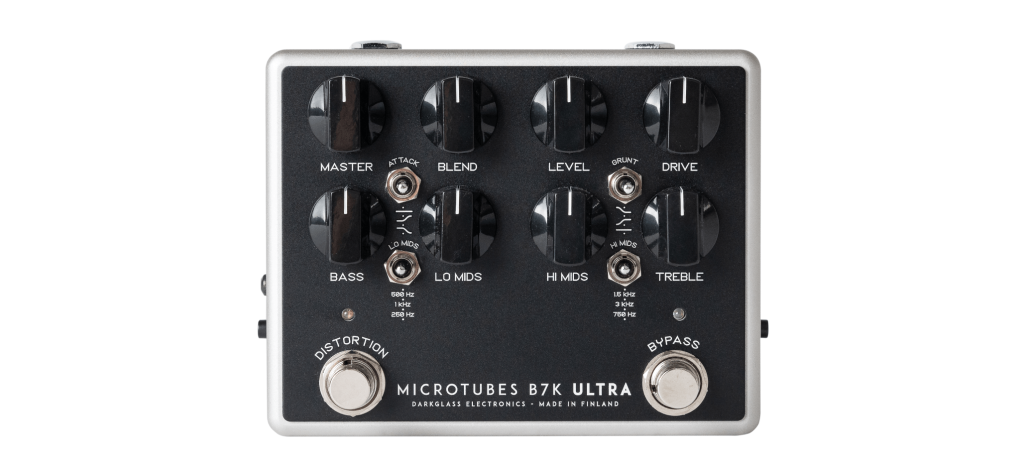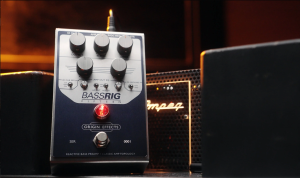A Decade of Defining Modern Bass Tone
Few bass pedals in the past 20 years have had the impact and staying power of the Darkglass Microtubes B7K. First released in the early 2010s by Finnish company Darkglass Electronics, the B7K (and its simpler sibling, the B3K) quickly became a cornerstone of modern bass sound, especially in genres like metal, progressive rock, djent, and fusion, but also in session, pop, and electronic music.
At its core, the B7K is a preamp/overdrive pedal that blends clear, aggressive distortion with a powerful EQ section, making it equally suited for clean tone shaping and harmonically rich grit. But what really made it a game changer was its ability to maintain articulation and clarity under gain — a feat few bass drives had managed without sacrificing low-end or note definition.
A Bit of History: The Rise of Darkglass
Founded by Douglas Castro in Helsinki in 2009, Darkglass emerged from a desire to build gear that could keep up with the demands of modern, technically complex music. At the time, most bass drives either lacked definition, lost bottom-end, or felt like adapted guitar circuits. Castro’s designs aimed to change that — and the B7K was the breakout product.
The B7K didn’t just offer distortion; it sculpted the tone of modern bass. It became a staple for touring professionals, bedroom producers, and recording engineers alike. Whether it was Nolly Getgood, Adam “Nolly” Getgood of Periphery, or countless players in the extended-range and multi-genre scenes, the B7K became synonymous with tight, mix-ready bass tone.

Features and Layout: The Power of Precision
The Microtubes B7K is both an overdrive and a preamp, featuring:
- Drive: Controls the amount of distortion. At lower settings, it’s gritty and present; crank it, and you get aggressive, cutting overdrive with no mud.
- Blend: This is key — lets you mix in your clean signal to retain note clarity and low-end punch.
- Level: Overall output control.
- Grunt: A 3-way low-end boost switch (Fat, Raw, Thin) at the input stage — choose how full and heavy your low end feels before gain.
- Attack: Another 3-way switch for high-end response. Adds bite, sheen, or smoothness depending on your tone.
- 4-Band EQ: With adjustable Low, Low Mid, High Mid, and Treble controls, plus selectable low-mid and high-mid frequencies (in the Deluxe version), giving surgical control over your tone.
- Direct Out: XLR balanced out for going straight to FOH or a recording interface.
- Parallel Output: A dry signal out, handy for bi-amping or multitrack recording.
The clean architecture and modular layout make the B7K extremely adaptable — it works equally well on pedalboards, in DAW environments, or as a preamp driving a power amp or interface.

Sound: Clarity Under Fire
The core appeal of the B7K lies in its precise and articulate gain structure. Where many bass overdrives mush out or lose clarity, the B7K delivers tight, punchy, mid-forward grit that remains focused even with extended-range basses or fast playing.
Key sonic characteristics:
- Modern edge: The drive is aggressive but not fuzzy or loose — ideal for cutting through dense mixes.
- Glass and bite: Thanks to the attack switch and EQ, the pedal can emphasize pick playing, slap, or articulate fingerstyle runs.
- Low-end preservation: With the blend knob and grunt switch, you maintain a strong sub presence without overwhelming the signal.
- Dynamic response: Despite its tight nature, the B7K is responsive. Playing softer or backing off the volume cleans it up nicely.
- Studio quality: Whether clean or dirty, the EQ and voicing feel “produced” — polished, refined, and ready to be printed.
While it shines in modern, aggressive settings, many players use it purely as an EQ/preamp, with minimal drive, for shaping live tone or adding sheen to studio DI tracks.
Why It Mattered — and Still Does
Before the B7K, the bass overdrive landscape was fractured. Players often had to choose between:
- Classic-style pedals (like the VT Bass or Tube Screamers) that colored the tone but muddied the lows.
- Clean boosts or fuzzes that lacked versatility.
- Or expensive rack gear.
The B7K solved this by offering studio-level tone sculpting in a pedal format, with enough gain for extreme players but enough transparency and flexibility for clean users. It bridged the gap between DI box, preamp, and distortion, becoming an all-in-one solution that was easy to trust on stage or in the studio.
And crucially, it helped usher in a new aesthetic of bass tone — forward, punchy, hi-fi, but with muscle.
Applications: More Than Just Metal
Though often associated with heavy genres, the B7K is a chameleon:
- Rock and punk: Dial in light drive, cut some mids, and you’ve got a roaring but defined rock tone.
- Pop and funk: Use the clean EQ section to enhance clarity and add snap without distortion.
- Electronic and synth-bass: With the blend and EQ, it becomes a bass shaping tool for hybrid or synth setups.
- Session work: Clean with a bit of grunt — glue your tone into the mix without stepping on toes.
It also integrates seamlessly with compressors, modulation, fuzz, and even IR loaders or amp sims.
Pros and Cons
Pros:
- Precise, clear, and powerful distortion that retains bass fundamentals
- Incredibly flexible 4-band EQ with sculpting switches
- Clean blend allows for tight low-end retention
- Studio-quality DI out — useful for live and recording
- Build quality is high-end and reliable
- Still a standard in pro-level rigs
Cons:
- Signature “modern” voicing isn’t for everyone — can sound too hi-fi for vintage purists
- Complex EQ may require careful dialing to avoid harshness
- No tube warmth — it’s very clean and “hard-edged”
- Price point is premium, though justified
Conclusion: A Modern Classic, Deservedly So
The Darkglass Microtubes B7K has earned its place in the pantheon of essential bass pedals. It’s not a flavor-of-the-month — it’s a true sonic tool, capable of everything from subtle enhancement to outright overdrive savagery, and always with a level of control that few other pedals offer.
For players who want to sound tight, modern, mix-ready, and defined, the B7K still reigns as one of the best options available. And for those who appreciate the value of a preamp that doubles as a studio channel strip, it’s arguably unmatched at its price point.
It changed the conversation about bass tone — and for many players, it still sets the standard.





